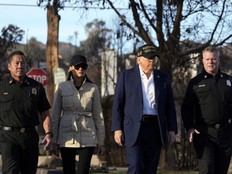Brampton council passes motion banning protests outside places of worship

Article content
Brampton city council has unanimously voted to pass a motion to ban “nuisance demonstrations” within 100 metres of places of worship following a series of violent protests in the city earlier this month.
The vote on the motion proposed by Mayor Patrick Brown happened on Wednesday and fines for disobeying the bylaw range between $500 and $100,000.
“(Essentially) it’s about the right to pray,” Brown said on the phone Wednesday afternoon with the Toronto Sun.
“Whether you go to a Mandir (a Hindu temple), a Gurdwara (a Sikh place of worship), a synagogue, a mosque, a church. Everyone has the right to pray free without harassment. We sought outside legal opinions to make sure it met the legal threshold and in Canada, when one right infringes another right, you can put a limit on those rights to support both. There’s a right to protest in Canada that’s constitutionally protected, but there’s also a right to religious freedom that is constitutionally and charted protected. So we feel in Brampton, we found the right balance.”
Nuisance demonstrations are defined as those where people feel intimidated, concerned for their safety or unable to access their place of worship.
The only exception is if a third party has rented out a church’s banquet hall for an event. In those cases, protests will be allowed and the renter has to pay for its own security.
This bylaw does not extend to protests at schools or hospitals — those issues fall under provincial jurisdiction.
Brown said he chose to introduce his motion after protests and counter-protests occurred on Nov. 3 outside of a Hindu temple and Sikh place of worship in Brampton and Mississauga, respectively, and then two days later there was a march by 500 people.
RECOMMENDED VIDEO
Videos appeared to show fist fights between protesters holding banners in support of a separate Sikh country called Khalistan and some holding India’s national flag, plus people striking each other with poles.
Five people have been charged so far.
“I was worried,” said Brown.
“What I felt was the protest and the counter-protest created an environment that was dangerous for our social cohesion and harmony. There were agitators on both sides. What I feel this bylaw does is it helps foster an environment where this is less likely to happen. And so by creating the separation, we’re not likely to have the intensity of these moments.”
The Canadian Civil Liberties Association previously issued a letter to the mayor and council opposing the bylaw, but Brown said he is not aware of any legal fights being launched so far.













Postmedia is committed to maintaining a lively but civil forum for discussion. Please keep comments relevant and respectful. Comments may take up to an hour to appear on the site. You will receive an email if there is a reply to your comment, an update to a thread you follow or if a user you follow comments. Visit our Community Guidelines for more information.